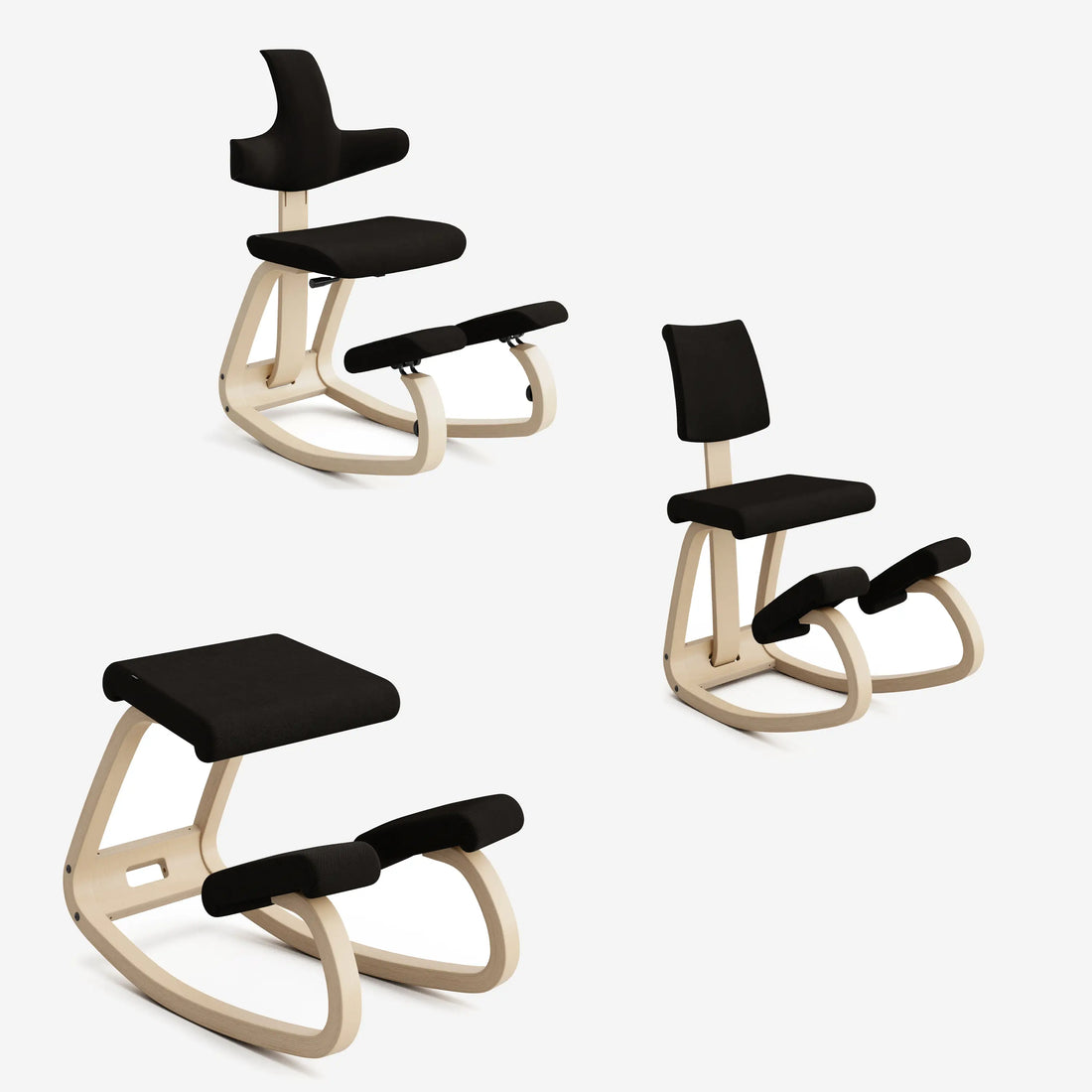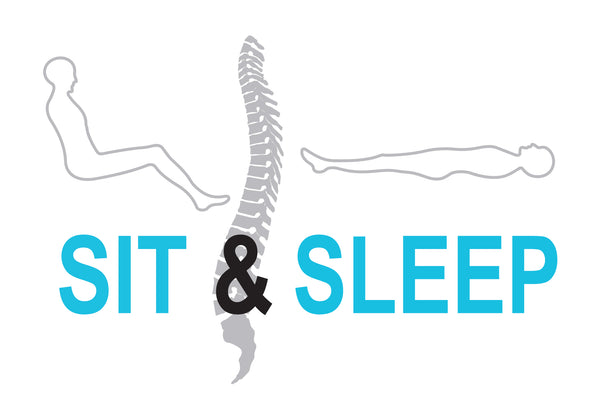
How do I choose a kneeling chair?
What is a knee chair?
The kneeling chair is characterized by the typical sitting position on the knees or shins. Sometimes other names are used, such as Swedish chair or balance chair.
With a kneeling chair, a clear distinction must be made between the one with a rocking mechanism and the stationary version.
A kneeling chair is one of the chair types that easily encourages you to maintain a healthy neutral back position and work actively. They have a seat that slopes forward. Your body is partially supported by the knee supports. This automatically creates an open hip angle, keeping your back in a neutral position.
This support structure consists of a wooden board with a thick layer of foam (4 cm) on top to absorb the pressure. This also applies to the knee supports, which should be given the necessary attention to minimize discomfort, including pressure on the shins.
Why a Knee Chair?
With a kneeling chair, the pressure on the intervertebral discs is reduced because the knees support a large portion of the weight. The seat is tilted forward so that the legs can hang in an open hip angle. These findings emerged during various studies. As early as 1976, research was conducted on how to sit more balanced and ergonomically. Through observation and measurements, it was discovered that a chair tilted slightly forward encouraged a natural posture. This posture provides greater mobility and relieves unwanted pressure while sitting. The concept of shin support was introduced to prevent the user from sliding off the chair. At the same time, it also maintains an open hip angle, with the pelvis higher than the knees and the thighs slightly sloping.
Open hip angle with the thigh sloping slightly
When you sit correctly on a kneeling chair, your back assumes a neutral position. This position is similar to the position your body assumes while walking or standing upright. This reduces strain on the back, neck, and shoulder muscle groups. As a result, you automatically adopt a more active working posture.
What is better chair or stool?
Research has shown that The neutral back position is better maintained, relative to the standing posture, when sitting on a kneeling chair than on a standard flat chair or stool. This applies to both upright and slumped postures, and to both back patients and healthy subjects.
Best kneeling chairs
It is the combination of the sloping seat with knee supports and the rocking base that ensures continuous distribution of pressure across the intervertebral discs, your seat and your knees. By using the "muscle pump" during movement, you also avoid circulation problems in the lower legs. Therefore, a dynamic model among kneeling chairs is the best option.
A dynamic model aims to address back pain. The weight can be shifted alternately to the knees or the seat. Small shifts in the body's center of gravity are followed by the seat, so the stabilizing muscles of the back are challenged differently each time. The underlying principle was that this is an ideal training method for engaging the right back-protecting muscles.
According to the concept of stabilization training, a backrest wouldn't really be necessary. However, it's a utopian dream that people possess such a strong muscular system that they can sit for long periods of time in this way. The back and neck muscles have to work harder compared to a conventional chair, which will tire them. Therefore, to prevent sagging during a long workday and to allow for posture variation, kneeling chairs with a backrest are available. Research has shown that using a lumbar support cushion while sitting relaxed is beneficial for reducing back strain.
The best kneeling chairs therefore consist of
- Swing function
- Backrest
- Adjustability/adjustability
Within the swing mechanism category there are 3 variants
The most basic variant is the knee chair, an instantly recognizable design icon. As the name suggests, the chair allows for varying positions. The curved legs allow for a gentle rocking motion, while a tilted seat allows for an open hip angle. The two supports under the seat can be used to rest your shins, one foot, both, or neither (by placing your feet on the floor). You can also turn around or sit to one side if you prefer. The chair is designed as an open structure, free of mechanical adjustment parts. It is lightweight and easy to move. The kneeling chair is intended for use with standard-height tables.
Kneeling chair
The kneeling chair with backrest is a further development of the iconic kneeling chair. With a fixed backrest and an upholstered cushion, it inspires you to vary even further between a wider range of seating positions. Meanwhile, it offers the unparalleled functionality of the original kneeling chair! The curvature of the wooden legs has been optimized, making finding and maintaining a balanced position both effortless and intuitive. The kneeling chair with backrest is also suitable for use at any standard table.
Knee chair with backrest
The adjustable knee chair is an evolution of the iconic knee chair. It's an ideal work chair for home or office use and is designed for seamless transitions between different positions. It features a wider seat, an adjustable backrest (both height and depth), and adjustable shin supports. The wingback is a perfect place to rest your elbows or turn around and lean your torso against it for variety. The chair invites you to lean both forward and backward.
Adjustable knee chair
Pros and cons
If you're tall, you may experience increased pressure on your knees when sitting in a kneeling chair. For tall or heavier people, a standard kneeling chair is often not ideal; they should try an adjustable kneeling chair.
A kneeling chair doesn't have armrests. To allow the muscles in your upper back and neck to relax sufficiently, your shoulders and arms must be supported by the table. "Supported" means that your shoulders are raised about 1 cm. At the same time, your forearm should ideally be horizontal. Your elbows should not hang lower than your forearm. The correct table height for a kneeling chair therefore depends on the length of your arms and upper body. A seat height of 50 cm means you'll be sitting slightly higher than on a standard chair. This might be convenient for the smallest among us, but taller people will be sitting too high relative to the table. A classic kneeling chair sometimes has a height-adjustable seat, but sitting even lower to get closer to the table means bending your knees even more for taller people and will not be tolerated. Getting up from a kneeling chair, which some people already find difficult (a problem that is frequently found) due to the specific posture, will also be difficult. For taller people, a kneeling chair usually doesn't offer a comfortable solution.
Although the studies are not uniformly positive, the kneeling chair also has its strong points.
You will experience the most benefit from your kneeling chair by varying your sitting positions and by regularly getting up and walking around.
The following advantages can be attributed to the use of a kneeling chair:
- Less strain. Using a kneeling chair distributes your body weight more effectively while sitting. This prevents strain on the spine, back, and legs.
- Train your core. A kneeling chair doesn't have a backrest. This requires you to maintain an active posture and keep your body balanced. Your body does this with your abdominal and back muscles. These become stronger the more you use your kneeling chair.
- More oxygen, more focus. The slight arch in your back opens your chest further. This makes deep breathing easier and increases your oxygen intake. This not only increases focus while you work but also promotes an active work posture.
- A kneeling chair is designed for seamless transitions between different positions.
Can I work on a kneeling chair for a long time?
Gradually increase your kneeling chair use and listen carefully to your body. If you have a standard kneeling chair, you can alternate with a regular chair. A kneeling chair with a backrest or an adjustable kneeling chair allows for more varied positions, allowing you to occasionally rest against the backrest. Above all, make sure you get plenty of exercise.
Prolonged use of a kneeling chair can become uncomfortable. This is because the pressure on your kneecaps increases. You may feel this especially when you're just starting to use a kneeling chair. We recommend gradually increasing your use of your kneeling chair (e.g., half an hour a day). Be careful not to put too much pressure on your knees; this can be achieved by not resting your full weight on them. The correct table height is also important for this!





